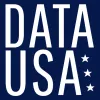Take a look inside 6 images
Data USA
Pros: The data is extensive, relevant, and interesting, and it's presented in a way that's easy to read and understand.
Cons: While extensive, there are still limitations -- you won’t find data for all industries, occupations, cities, schools, or other countries.
Bottom Line: An efficient research tool that makes it easier to incorporate stats into a host of lessons or projects focusing on the U.S.
One way to kick off Data USA in your classroom is to have students explore one specific data set (for instance, looking at poverty rates on the Maps feature). Task students with finding something they think is interesting about the data, and then have them draft a question they'd like to explore based on what they found.
That's only the tip of the iceberg, though. Teachers from many subject areas can find uses for Data USA, whether they be in social studies, science, math, or career planning. Social studies, government, and economics teachers will like it for projects or discussions related to U.S. demographics, economics, and government indicators. Science and math teachers can get students to practice graph interpretation, map analysis, and statistical calculations. The occupation and education research pages are ideal for college and career planning research -- never too early for students to start this! Teachers will like that they can download any of the graphs, embed graphs on their websites, or share via social media (if they use this with students). The site seems like an ideal resource for a cross-curricular project in social studies, science, and math.
Data USA is a data-search and -visualization website that aims to make U.S. government data more accessible to the public. Data sources include the U.S. Census, the U.S. Department of Labor, the University of Wisconsin Population Health Institute, and the National Center for Education Statistics. Data USA removes the tedium of finding and sorting through often esoteric and unappealing sets of data across disparate websites, instead giving students a one-stop shop for well-visualized research on a range of topics such as the economy, demographics, education, housing and living, health, and safety. They can find information organized by location, industry, occupation, and post-secondary school.
The site is clean and intuitive, which makes searching for common data/stats very easy. The results are displayed in a simple, well-organized way, with colorful graphs. There's a map-search page that will show data for a number of topics overlaid on a U.S. map. There are also several short articles that highlight stats related to various topics as well.
Data USA was not designed for classrooms necessarily, but teachers and students will find its super-easy search functions and simple visualizations useful to teach statistics and data analysis; to kick off research projects; or to supplement lessons on a range of content with real and relevant statistics. All graphs have interactive keys and rollover info that displays data and margin of error. Users can find explanations of various stat calculations (including some formulas). You also have the option to see data tables and link to the data sources used to make each graph. Students will be able to look at two data sets side by side using the Add Comparison button. All these features make this site a reliable and easy-to-use research tool that is great for all students, including visual learners and English learners. Still, don't expect any plug-and-play lessons or classroom-specific support, and, while there's tons here to explore, the data is limited to the U.S.














